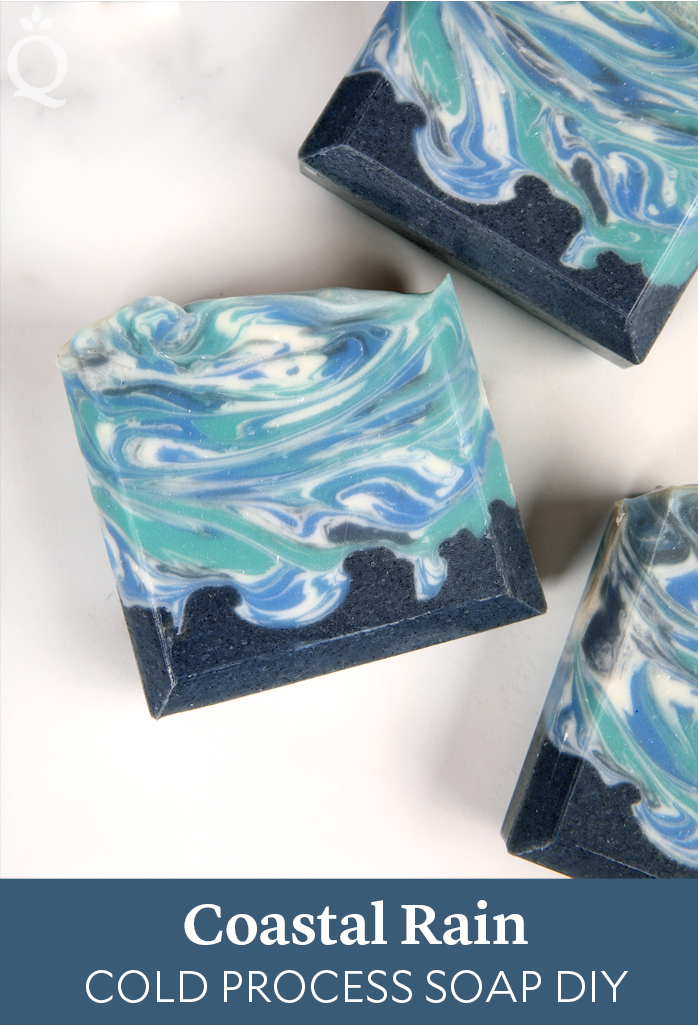
An in-the-pot swirl is a classic soapmaking technique that results in a unique design every time. The batch is portioned off into separate containers, color is added, and the soap is poured back into the main batch. The colors are poured into different areas of the pot and at different heights. The imprecise nature of the swirl makes it great for beginners and advanced makers alike.
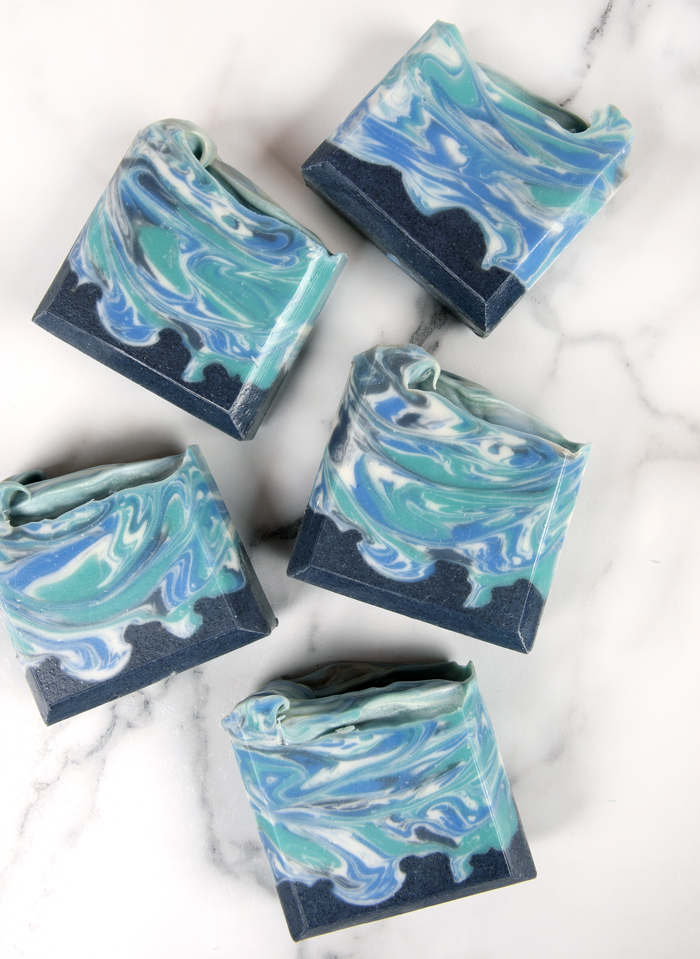
This Coastal Rain Cold Process Soap uses multiple shades of blue. Jagua blue extract creates a natural blue hue and Icelandic black sand adds depth to the bottom layer, as well as a touch of exfoliation. When working with Kelly Green Mica, don’t be afraid of the olive green color it creates at first – it returns to a bright shade of green in finished soap.
The batch is scented with Coastal Rain Fragrance Oil, which features notes of ocean mist, white tea, lily, and musk. It does discolor to a light yellow, which is why titanium dioxide is added. We found it did discolor the top of the soap, giving it a slight green hue.
The Coastal Rain Fragrance Oil, Icelandic black sand, and jagua blue extract are all part of the new Seascape Collection. It includes four ocean-inspired fragrance oils, exfoliants, sugar pearls, and more. Click here to shop the entire collection.
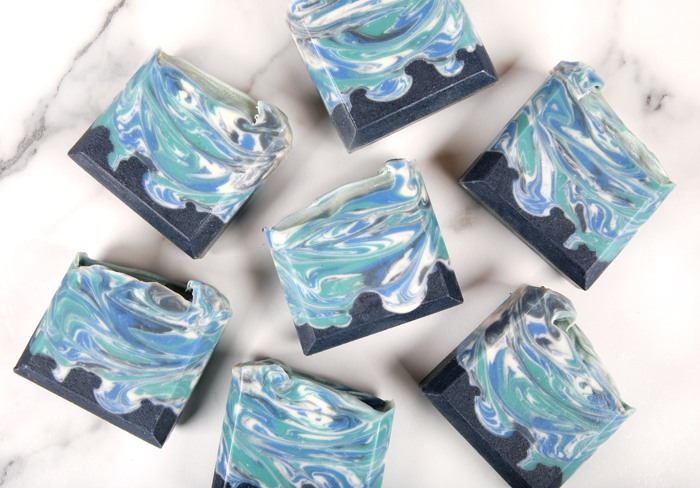
If you've never made cold process soap before, stop here. We highly recommend checking out our FREE four part SoapQueen.tv series on cold process soapmaking, especially the episode on lye safety. And if you'd rather do some reading, Bramble Berry carries a wide range of books on the topic, including Pure Soapmaking. You can also check out the digital downloads for that instant gratification factor.
FRAGRANCE PREP: Measure 3.4 ounces of Coastal Rain Fragrance Oil into a small glass container and set aside.
COLORANT PREP: Disperse 3 teaspoons of titanium dioxide into 2 tablespoons of a lightweight liquid oil such as sunflower or sweet almond oil. In separate containers, disperse 1 teaspoon Kelly Green Mica, 1 teaspoon activated charcoal, and 1 teaspoon Ultramarine Blue Pigment into 1 tablespoon of lightweight liquid oil. Use a mini mixer to get rid of clumps. Then, mix together 1/2 teaspoon of jagua blue extract with 1/2 tablespoon of distilled water. Be very careful with this mixture – it’s highly concentrated and will stain skin and other surfaces. Use a small spoon to mix together the jagua blue extract and water. If necessary, you can use a mini mixer to help get rid of clumps. We recommend covering the container with your hands if you use the mixer, it can cause the water to spray.
Optional: To ensure the titanium dioxide blends smoothly into the soap, we recommend micronizing it before dispersing it in oil. Use a coffee grinder to break up any clumps of color and prevent streaks of white from showing in the final soap. We like to use a coffee grinder that has a removable stainless steel mixing area for easy cleaning.
SAFETY FIRST: Suit up for safe handling practices. That means goggles, gloves, and long sleeves. Make sure kids, pets, other distractions, and tripping hazards are out of the house or don't have access to your soaping space. Always soap in a well-ventilated area.
ONE: Slowly and carefully add 7.5 ounces of lye to 16 ounces of distilled water. Gently stir until the lye has fully dissolved. Set it aside to cool. If you'd like a harder bar of soap that releases faster from the mold, you can add sodium lactate to the cooled lye water. Use 1 teaspoon of sodium lactate per pound of oils in the recipe. For this recipe, you'd add 3.5 teaspoons sodium lactate.
TWO: Fully melt the entire bag of Swirl Quick Mix until it's completely clear. Shake the bag to mix up all the oils. Measure 54 ounces into your soaping bowl. Once the lye water and the oils have cooled to 130 degrees F or below (and are ideally within 10 degrees of each other), add the lye water to the oils and stick blend the mixture to a thin trace.
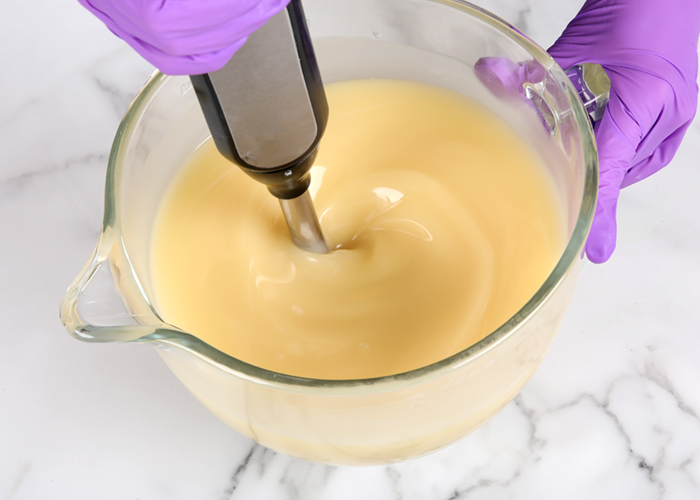 THREE: Add 1 tablespoon of dispersed titanium dioxide to the entire batch and use a whisk to mix it in.
THREE: Add 1 tablespoon of dispersed titanium dioxide to the entire batch and use a whisk to mix it in.
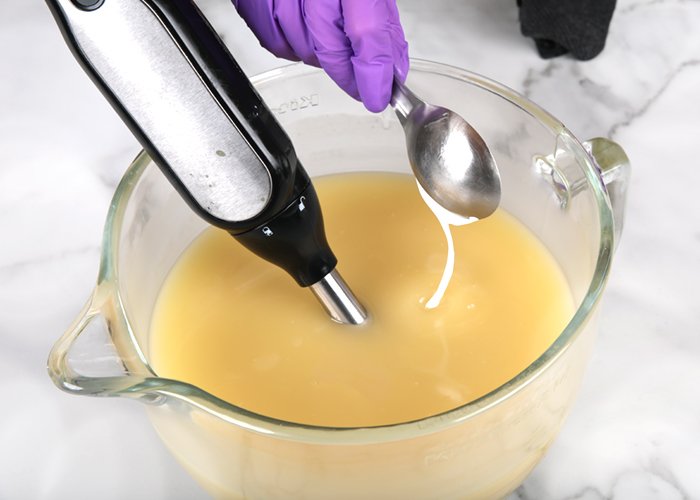 FOUR: Split the soap and add the dispersed colorants listed below. Use a whisk to mix each colorant in.
FOUR: Split the soap and add the dispersed colorants listed below. Use a whisk to mix each colorant in.
- Container A (500 mL): 1 teaspoon dispersed Kelly Green Mica + 1/2 tsp. dispersed Ultramarine Blue Pigment
- Container B (500 mL): Remaining dispersed titanium dioxide pigment
- Container C (500 mL): 1 teaspoon dispersed Ultramarine Blue Pigment
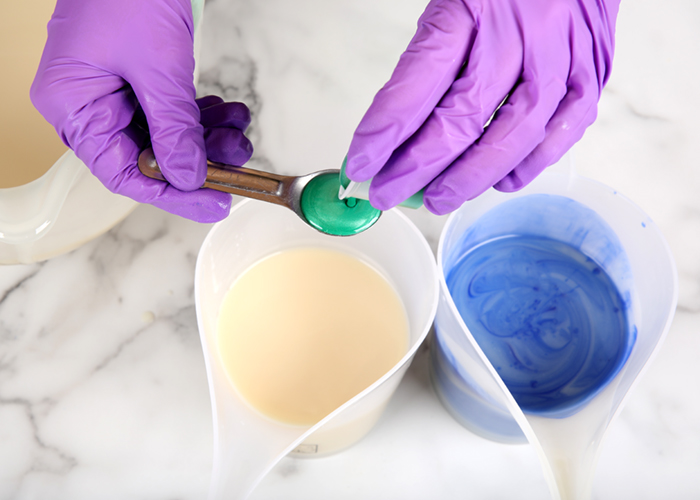
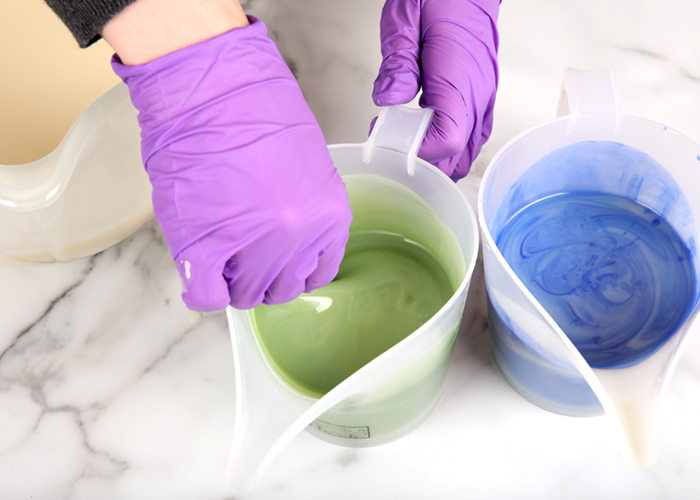
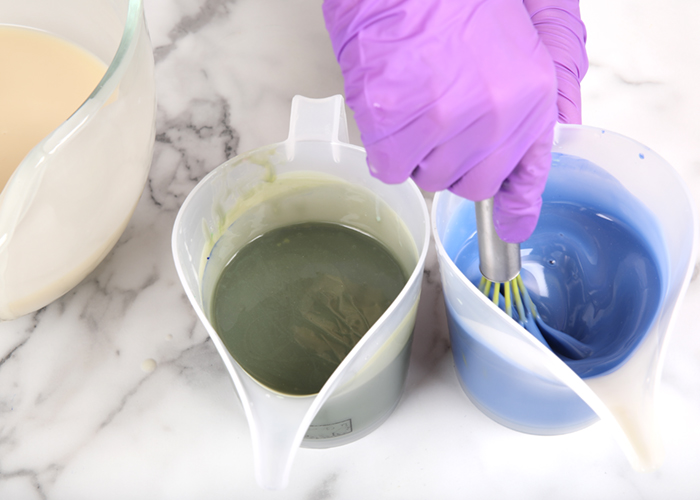 Kelly Green Mica turns a dark olive green when first added, but it returns to a bright green in the finished soap. Notice the color change from the photos above.
Kelly Green Mica turns a dark olive green when first added, but it returns to a bright green in the finished soap. Notice the color change from the photos above.
FIVE: To the remaining soap, add all of the dispersed jagua blue extract and use a whisk to mix it in thoroughly.
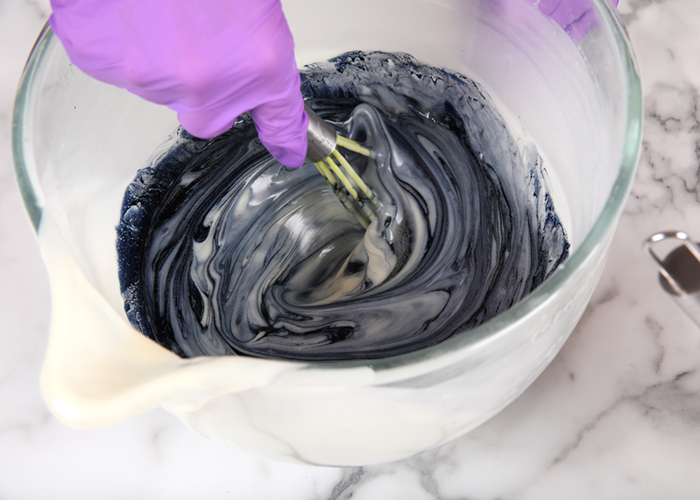 SIX: Pour off 500 mL of the jagua blue colored soap into a separate container. Stick blend the soap to reach a medium trace. Add 2 tablespoons of Icelandic black sand and 2 teaspoons of dispersed activated charcoal, and use a whisk to fully incorporate. Add a proportional amount of the Coastal Rain Fragrance Oil (it’s okay to eyeball it) and use a whisk to mix in.
SIX: Pour off 500 mL of the jagua blue colored soap into a separate container. Stick blend the soap to reach a medium trace. Add 2 tablespoons of Icelandic black sand and 2 teaspoons of dispersed activated charcoal, and use a whisk to fully incorporate. Add a proportional amount of the Coastal Rain Fragrance Oil (it’s okay to eyeball it) and use a whisk to mix in.
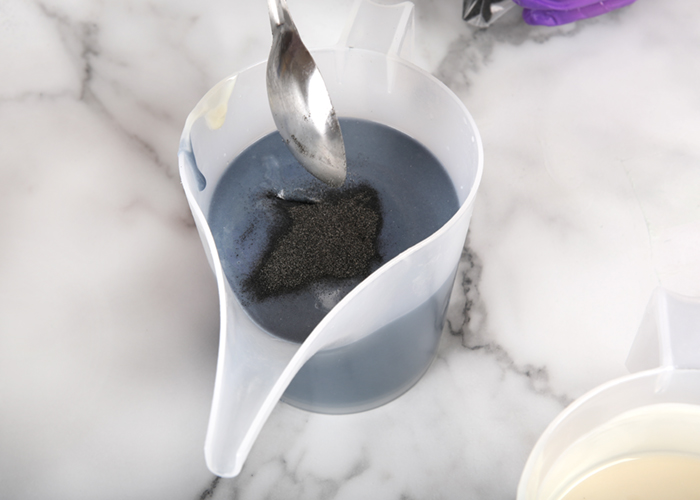 SEVEN: Pour the dark jagua blue soap into the mold. Use a spoon to evenly spread it throughout the mold and to create peaks and divots into the soap.
SEVEN: Pour the dark jagua blue soap into the mold. Use a spoon to evenly spread it throughout the mold and to create peaks and divots into the soap.
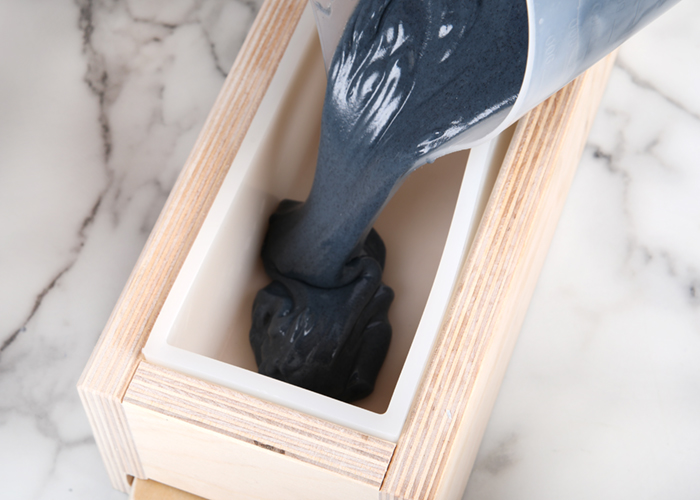
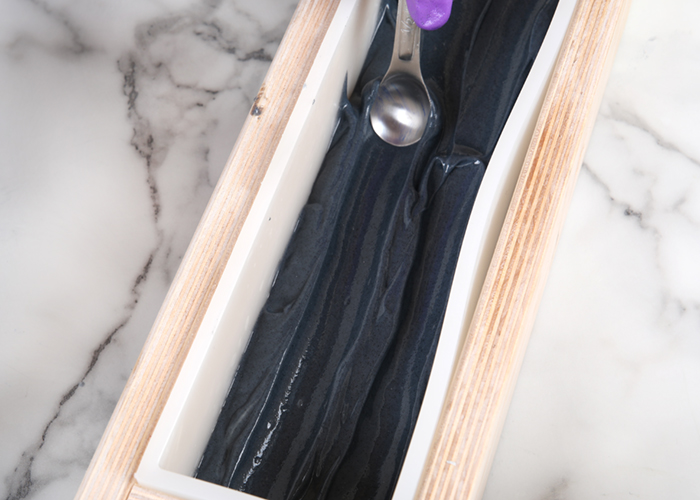 EIGHT: Add the Coastal Rain Fragrance Oil proportionally to each of the remaining containers of soap – it’s okay to eyeball it. Use a whisk to fully mix in the fragrance oil.
EIGHT: Add the Coastal Rain Fragrance Oil proportionally to each of the remaining containers of soap – it’s okay to eyeball it. Use a whisk to fully mix in the fragrance oil.
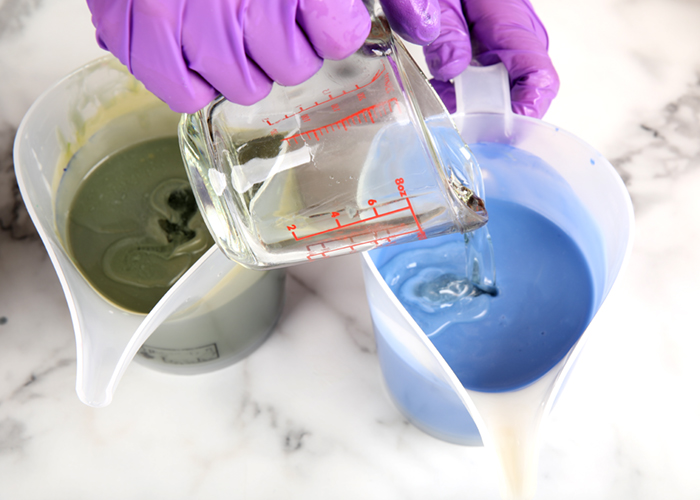 NINE: Begin pouring the blue, green, and white soap into the large bowl of jagua blue soap. Pour each color into different areas of the bowl and at different heights. Don’t worry too much about the exact placement of each color. We like to pour a little bit of white in between each color to help differentiate the colors.
NINE: Begin pouring the blue, green, and white soap into the large bowl of jagua blue soap. Pour each color into different areas of the bowl and at different heights. Don’t worry too much about the exact placement of each color. We like to pour a little bit of white in between each color to help differentiate the colors.
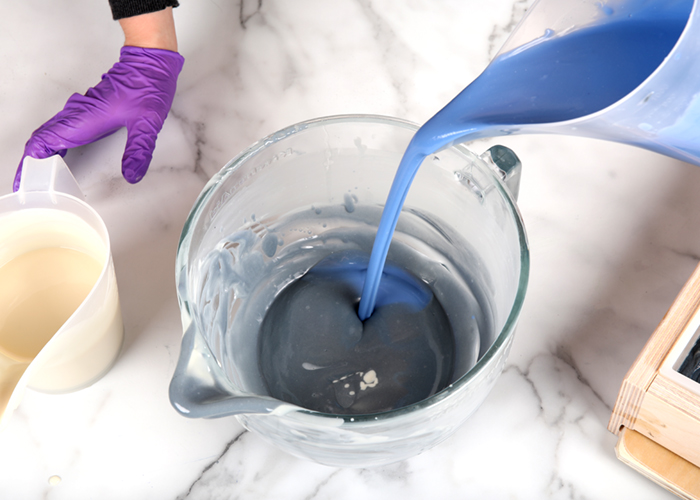
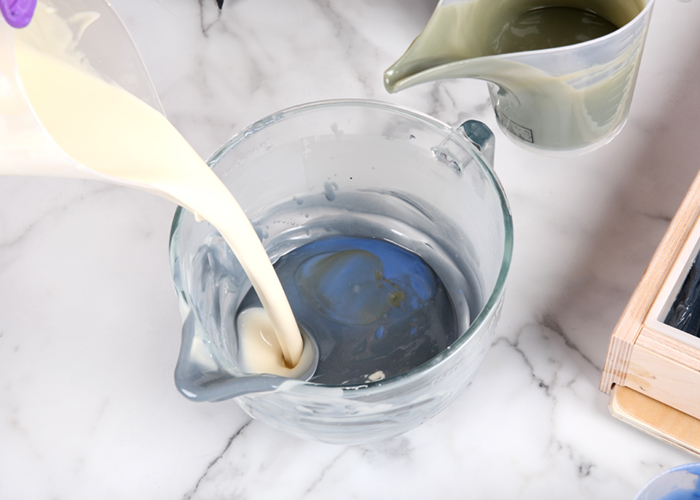
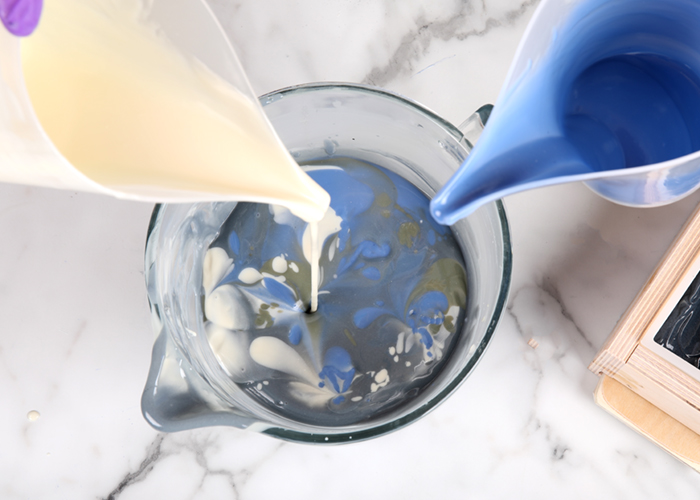 TEN: Once all the colors have been poured into the bowl, use a large spatula to swirl the batter. Only swirl 1-2 times so the colors don’t muddle together.
TEN: Once all the colors have been poured into the bowl, use a large spatula to swirl the batter. Only swirl 1-2 times so the colors don’t muddle together.
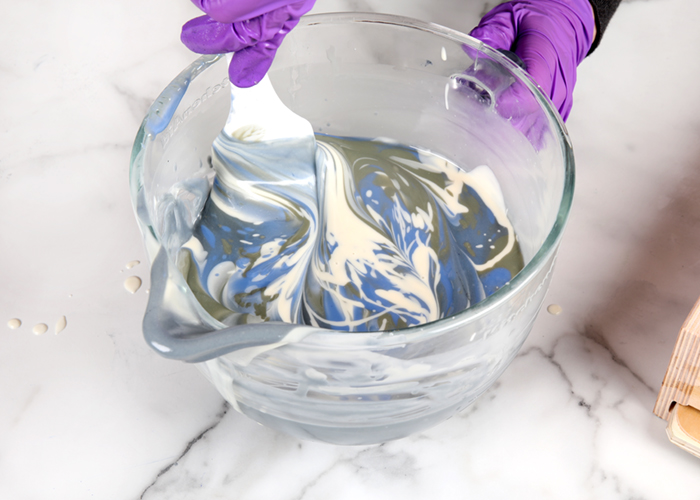 ELEVEN: Pour the soap into the mold. Tap it firmly on the counter to help get rid of bubbles.
ELEVEN: Pour the soap into the mold. Tap it firmly on the counter to help get rid of bubbles.
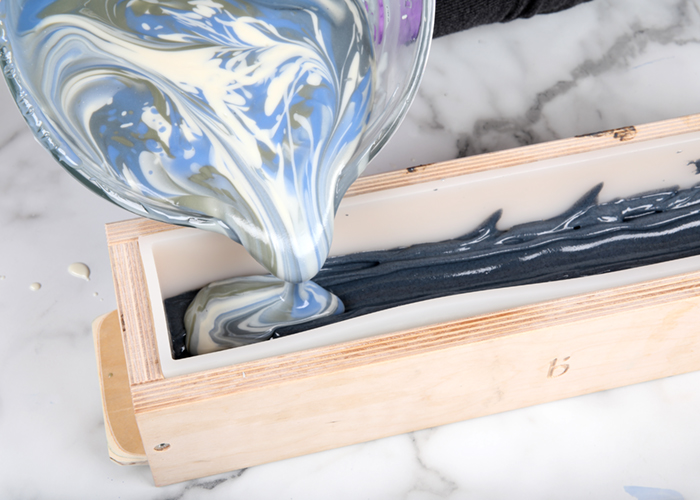
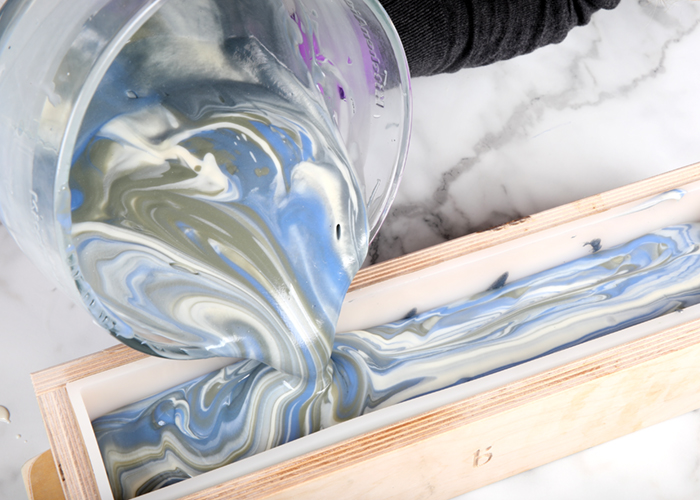 TWELVE: Allow the soap to sit in the mold and thicken. This will take about 3-5 minutes. Once it’s firm, use a small spoon to create texture. We created a wave on one side of the mold, but feel free to texture the top however you like.
TWELVE: Allow the soap to sit in the mold and thicken. This will take about 3-5 minutes. Once it’s firm, use a small spoon to create texture. We created a wave on one side of the mold, but feel free to texture the top however you like.
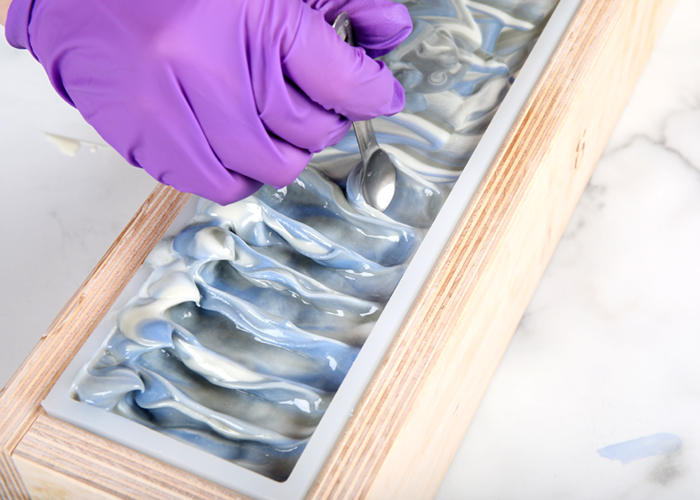
To promote gel phase, place the soap on a heating pad set to medium for 30-60 minutes. To help insulate, we bent a piece of cardboard and placed it on over the mold without touching the top. Allow it to stay covered and insulated for at least 6 hours. Keep an eye on it to make sure it doesn’t get too hot and crack. If you see a crack starting to form, take it off the heating pad and remove any insulation.
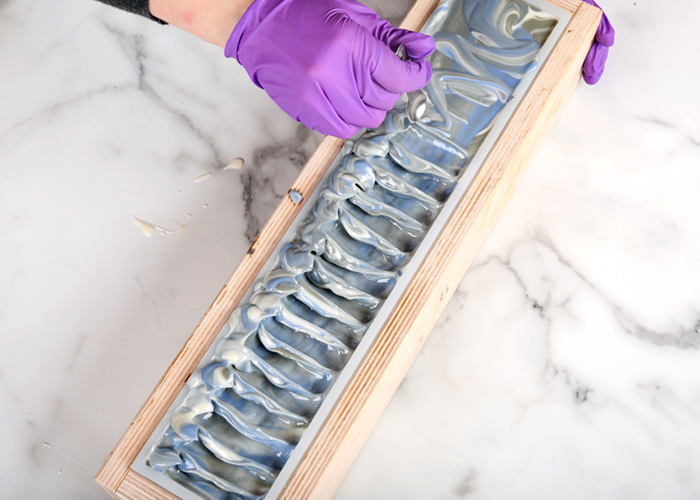
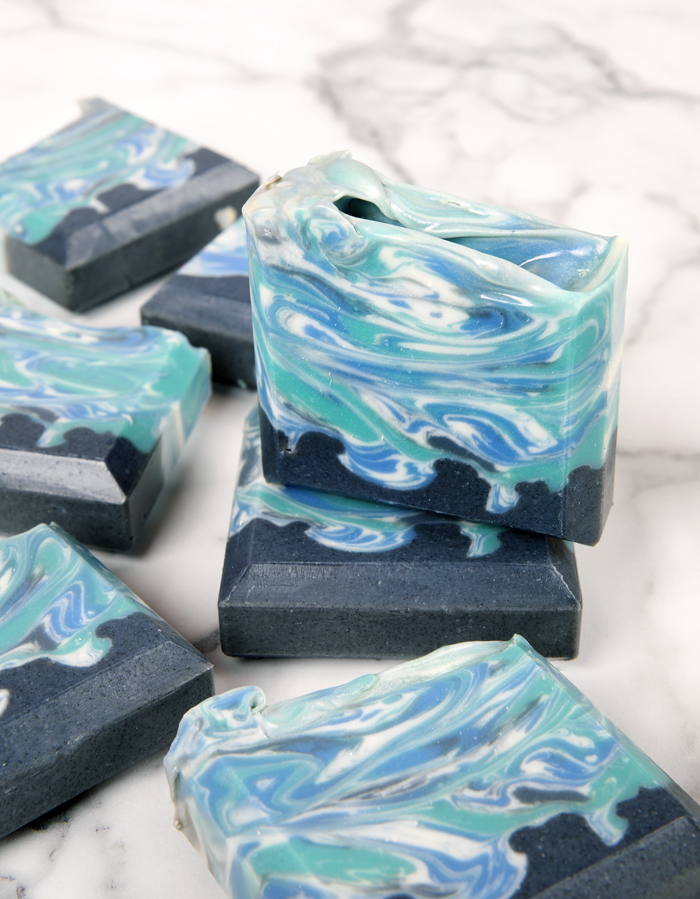
Coastal Rain Cold Process Soap Tutorial
Author: Soap Queen
Recipe type: Cold Process Soap
- 5 Pound Mold with Sliding Bottom
- Silicone Liner for 5 lb. Wood Mold
- 54 oz. Swirl Quick Mix
- 7.5 oz. Sodium Hydroxide Lye
- 16 oz. Distilled Water (10% water discount)
- 3.4 oz. Coastal Rain Fragrance Oil
- Jagua Blue Extract
- Icelandic Black Sand
- Titanium Dioxide Pigment
- Ultramarine Blue Pigment
- Kelly Green Mica
- Activated Charcoal
- Slowly and carefully add 7.5 ounces of lye to 16 ounces of distilled water. Gently stir until the lye has fully dissolved. Set it aside to cool. If you'd like a harder bar of soap that releases faster from the mold, you can add sodium lactate to the cooled lye water. Use 1 teaspoon of sodium lactate per pound of oils in the recipe. For this recipe, you'd add 3.5 teaspoons sodium lactate.
- Fully melt the entire bag of Swirl Quick Mix until it's completely clear. Shake the bag to mix up all the oils. Measure 54 ounces into your soaping bowl. Once the lye water and the oils have cooled to 130 degrees F or below (and are ideally within 10 degrees of each other), add the lye water to the oils and stick blend the mixture to a thin trace.
- Add 1 tablespoon of dispersed titanium dioxide to the entire batch and use a whisk to mix it in.
- Split the soap and add the dispersed colorants listed below. Use a whisk to mix each colorant in.
Container A (500 mL): 1 teaspoon dispersed Kelly Green Mica + ½ tsp. dispersed Ultramarine Blue Pigment
Container B (500 mL): Remaining dispersed titanium dioxide pigment
Container C (500 mL): 1 teaspoon dispersed Ultramarine Blue Pigment - To the remaining soap, add all of the dispersed jagua blue extract and use a whisk to mix it in thoroughly.
- Pour off 500 mL of the jagua blue colored soap into a separate container. Stick blend the soap to reach a medium trace. Add 2 tablespoons of Icelandic black sand and 2 teaspoons of dispersed activated charcoal, and use a whisk to fully incorporate. Add a proportional amount of the Coastal Rain Fragrance Oil (it's okay to eyeball it) and use a whisk to mix in.
- Pour the dark jagua blue soap into the mold. Use a spoon to evenly spread it throughout the mold and to create peaks and divots into the soap.
- Add the Coastal Rain Fragrance Oil proportionally to each of the remaining containers of soap – it's okay to eyeball it. Use a whisk to fully mix in the fragrance oil.
- Begin pouring the blue, green, and white soap into the large bowl of jagua blue soap. Pour each color into different areas of the bowl and at different heights. Don't worry too much about the exact placement of each color. We like to pour a little bit of white in between each color to help differentiate the colors.
- Once all the colors have been poured into the bowl, use a large spatula to swirl the batter. Only swirl 1-2 times so the colors don't muddle together.
- Pour the soap into the mold. Tap it firmly on the counter to help get rid of bubbles.
- Allow the soap to sit in the mold and thicken. This will take about 3-5 minutes. Once it's firm, use a small spoon to create texture. We created a wave on one side of the mold, but feel free to texture the top however you like.
- To promote gel phase, place the soap on a heating pad set to medium for 30-60 minutes. To help insulate, we bent a piece of cardboard and placed it on over the mold without touching the top. Allow it to stay covered and insulated for at least 6 hours. Keep an eye on it to make sure it doesn't get too hot and crack. If you see a crack starting to form, take it off the heating pad and remove any insulation.
3.3.3077
The post Coastal Rain Cold Process Soap Tutorial appeared first on Soap Queen.




 THREE: Add 1 tablespoon of dispersed titanium dioxide to the entire batch and use a whisk to mix it in.
THREE: Add 1 tablespoon of dispersed titanium dioxide to the entire batch and use a whisk to mix it in. FOUR: Split the soap and add the dispersed colorants listed below. Use a whisk to mix each colorant in.
FOUR: Split the soap and add the dispersed colorants listed below. Use a whisk to mix each colorant in.

 Kelly Green Mica turns a dark olive green when first added, but it returns to a bright green in the finished soap. Notice the color change from the photos above.
Kelly Green Mica turns a dark olive green when first added, but it returns to a bright green in the finished soap. Notice the color change from the photos above. SIX: Pour off 500 mL of the jagua blue colored soap into a separate container. Stick blend the soap to reach a medium trace. Add 2 tablespoons of Icelandic black sand and 2 teaspoons of dispersed activated charcoal, and use a whisk to fully incorporate. Add a proportional amount of the Coastal Rain Fragrance Oil (it’s okay to eyeball it) and use a whisk to mix in.
SIX: Pour off 500 mL of the jagua blue colored soap into a separate container. Stick blend the soap to reach a medium trace. Add 2 tablespoons of Icelandic black sand and 2 teaspoons of dispersed activated charcoal, and use a whisk to fully incorporate. Add a proportional amount of the Coastal Rain Fragrance Oil (it’s okay to eyeball it) and use a whisk to mix in. SEVEN: Pour the dark jagua blue soap into the mold. Use a spoon to evenly spread it throughout the mold and to create peaks and divots into the soap.
SEVEN: Pour the dark jagua blue soap into the mold. Use a spoon to evenly spread it throughout the mold and to create peaks and divots into the soap.
 EIGHT: Add the Coastal Rain Fragrance Oil proportionally to each of the remaining containers of soap – it’s okay to eyeball it. Use a whisk to fully mix in the fragrance oil.
EIGHT: Add the Coastal Rain Fragrance Oil proportionally to each of the remaining containers of soap – it’s okay to eyeball it. Use a whisk to fully mix in the fragrance oil. NINE: Begin pouring the blue, green, and white soap into the large bowl of jagua blue soap. Pour each color into different areas of the bowl and at different heights. Don’t worry too much about the exact placement of each color. We like to pour a little bit of white in between each color to help differentiate the colors.
NINE: Begin pouring the blue, green, and white soap into the large bowl of jagua blue soap. Pour each color into different areas of the bowl and at different heights. Don’t worry too much about the exact placement of each color. We like to pour a little bit of white in between each color to help differentiate the colors.

 TEN: Once all the colors have been poured into the bowl, use a large spatula to swirl the batter. Only swirl 1-2 times so the colors don’t muddle together.
TEN: Once all the colors have been poured into the bowl, use a large spatula to swirl the batter. Only swirl 1-2 times so the colors don’t muddle together. ELEVEN: Pour the soap into the mold. Tap it firmly on the counter to help get rid of bubbles.
ELEVEN: Pour the soap into the mold. Tap it firmly on the counter to help get rid of bubbles.
 TWELVE: Allow the soap to sit in the mold and thicken. This will take about 3-5 minutes. Once it’s firm, use a small spoon to create texture. We created a wave on one side of the mold, but feel free to texture the top however you like.
TWELVE: Allow the soap to sit in the mold and thicken. This will take about 3-5 minutes. Once it’s firm, use a small spoon to create texture. We created a wave on one side of the mold, but feel free to texture the top however you like.


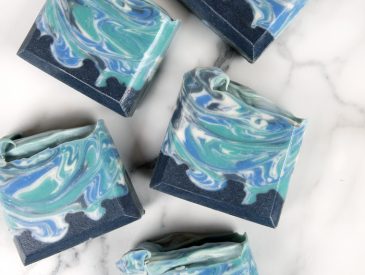
Keine Kommentare:
Kommentar veröffentlichen